January 28th, 2011
| 10 Comments »
Sometimes all it takes for me to leap into a new recipe idea is something completely random that I either read or hear. It makes my culinary brain start spinning, usually because it’s a food item I’ve never heard of and have no clue as to what it is. I am nothing without my near obsessive need to understand all aspects of food, and when faced with this empty space in my food dictionary, I am unable to resist the urge to learn, to know more and to understand.
Take Horchata, for example. I’d never heard of it before seeing one brief mention of it from someone on Twitter, along with the question of how it could possibly create a stunning French Toast, and I basically leapt into researching it like I’d been shot from a rocket. Strange, I know, but my brain likes to evolve; I’m not content to rest on any kind of laurels with my quest to find out as much as I can about the cuisines of the world. Horchata, for those uninitiated, is a cool and refreshing drink, usually a type of aqua fresca, served traditionally with Mexican style meals. It’s light, creamy and easily pairs with most any foods, especially dishes with a lot of spice and heat. It’s not, however, made with milk so it’s a lovely dairy free beverage.
The standard Horchata recipe combines ground rice and almonds with water, lime juice and zest and cinnamon. This mixture is saturated with water and allowed to stand overnight, then it’s drained, resulting in a delicious liquid that you sweeten with either white or brown sugar. I wasn’t at all certain how it would taste, but my first sip dashed away any doubt; this was stellar, and here I was enjoying it zealously during some of the coldest days of our Minnesota winter. For a hot summer day, I would imagine this is a perfect accompaniment to a sultry afternoon, and I look forward to the day that I can test that theory. For now, I’ll settle with it being the base to the best tasting french toast that’s crossed my kitchen counters in a long, long time.
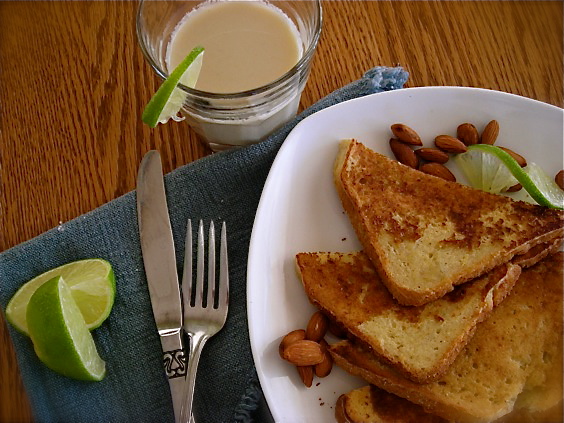
French toast is really not that interesting of a dish. There’s a creamy custard that you dip slices of bread into, which are then cooked on a hot skillet, doused with syrup, spread with jam or maybe sprinkled with powdered sugar. It’s simple and basic, and really, the bread you use can make or break the final result. But overall, there’s little you can do to make the dish leap from it’s ubiquitous nature to something altogether stunning. Unless you start with Horchata as your base.
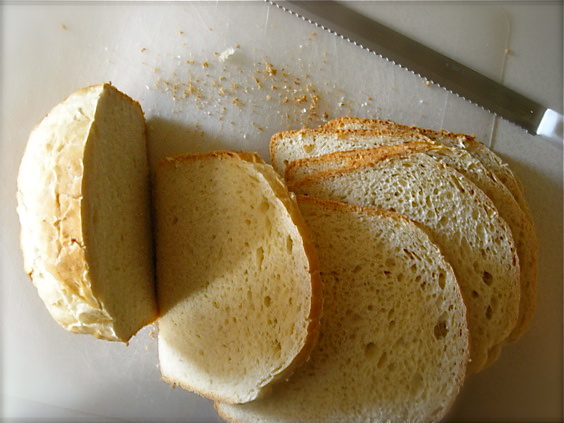
The Horchata, when made from scratch, only requires forethought to prepare. Most of the work is done as it sits on your counter, marrying the amazing flavors of almond, lime and cinnamon together. Strain it, sweeten it and chill it and you’ve got a pitcher of perfection whenever you need cool refreshment. I looked to the most trusted source for South of the border delights, the never fail Lisa of Homesick Texan, and sure enough, she had a recipe for Horchata that came straight from Rick Bayless. Between those two, there was no way this would disappoint.
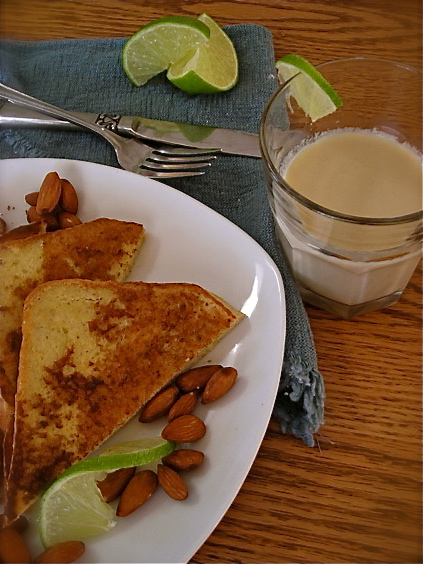
And it didn’t. Nutty from the almonds, zesty with lime and lush with light, refreshing flavor, the French Toast was a delight from first bite to last. It needed only a minimal drizzle of maple syrup to make it perfect. Make up a big batch if you can; the flavor sustains itself in your refrigerator, making it perfect to have on hand for a delicious and quick breakfast.
Horchata
Ingredients:
2/3 cup of uncooked rice
1 1/4 cups of blanched almonds
1 teaspoon of lime juice
Zest from one lime
1 cinnamon stick
1 teaspoon vanilla extract
1 cup of sugar or brown sugar, depending on how dark you want the drink
Method:
In a blender or spice grinder, grind the rice until it’s powdery. Place ground rice, almonds, lime juice, lime zest and the cinnamon stick in a pot and cover with two cups of warm water. Let stand overnight or for eight hours.
After the mixture has soaked, take out the cinnamon stick and pour contents into a blender with two cups of water and blend until smooth. Take a mesh colander that has been double lined with cheesecloth, and over a bowl or pitcher slowly pour the mixture, wringing the cheesecloth to get every last drop out. You should have a milky, smooth liquid at this point. If there are still rice and almond bits floating around, strain it again.
In a pot, heat up one cup of sugar and one cup of water on medium heat until the sugar has dissolved. Stir this sugar water into the horchata, along with the vanilla. Add one more cup of water and serve over ice or chilled. Mixture may separate under refrigeration. Just stir to combine.
(From Homesick Texan, and adapted from Rick Bayless)
Horchata French Toast
2 c. prepared Horchata
3 eggs
1 t. ground cinnamon
2 T. natural cane sugar or brown sugar
Whisk custard ingredients in large wide bowl. Heat skillet until a drop of water sizzles and vaporizes on impact. Dip bread into custard and cook until browned on one side; flip over and repeat.
May 7th, 2010
| 9 Comments »
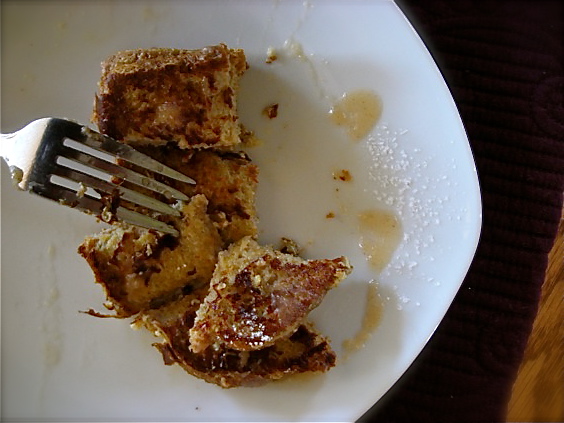
Have I mentioned my new job? No? I can’t believe I haven’t shouted it from every rooftop I find. I’m pretty excited for it. I’m the Garde Manger chef at a local Yacht club. It’s a seasonal job through early October, but it’s good work and a paycheck right now is a huge blessing. Most of you may remember that the job situation for me lately hasn’t been all that rosy. Thankfully, for a while anyway, we will be breathing easier.
But I am working a lot, as I hoped to be. And since most of the past 18 months have been idle ones for me, to be on my feet working in the very physical job that is a professional kitchen, I’ve been fairly worn out. But it’s getting better, as I get more accustomed to the work, the pace and being on my feet all day long. My schedule, once it settles in, likely will keep me working into the early evening hours. That means Mike and Griffin will be fending for themselves for dinner most of the time. Thank goodness for good shoes and understanding spouses. I have both, and they’re making this transition so much easier on me.
A recent Sunday morning came that I simply could not raise my weary head from my pillow and the guys went off to church while I cuddled the two content felines and dozed through a sunny, but chilly early morning. By 9:00am I felt like I could stumble down the stairs and operate the coffee pot with a fair amount of dexterity, and by 10:00 or so, I was particularly famished. On top of all that physical work comes the accompanying expenditure of calories, and I have been so hungry I can hardly believe it. With the guys gone, I could make something with eggs and not offend my egg-o-phobic spouse and it had been ages since a piece of French Toast had crossed my plate. I spied a container of cooked fresh rhubarb and on a whim, I dumped a few spoonfuls into the batter, dunked my bread into it and placed it in the skillet.

I didn’t really know what to expect, but I like rhubarb, and I like French Toast. Sometimes I get kind of a wild hair about combining two things I love into one, and often I am rewarded greatly. Other times…. meh. It either doesn’t work or I just don’t like it, leaving me to try and continually remind myself that just because it tastes great separately, it doesn’t exactly make it a match made in heaven. But this…. hot, caramelized Rhubarb French Toast. Oh, this worked. Beautifully.
And here’s the thing; it’s Rhubarb season, is it not? The stalks are everywhere, and if you’ve got friendly neighbors or friends with a big patch, it’s pretty likely that some has been pawned off into your eager hands. What do most people do with rhubarb? Make a cobbler, sure. A pie?? Oh absolutely! Rhubarb sauce? For certain. And that was what I did with the small sack that made it’s way into my kitchen. It doesn’t take much. Time on the stove. Some brown sugar. A few turns with a spoon and you’ve got a delicious and versatile sauce for ice cream, yogurt, biscuits or even just to scoop up happily for a treat. Or, as it worked out, into your French Toast batter like I did. I took the mystery out of it for you.
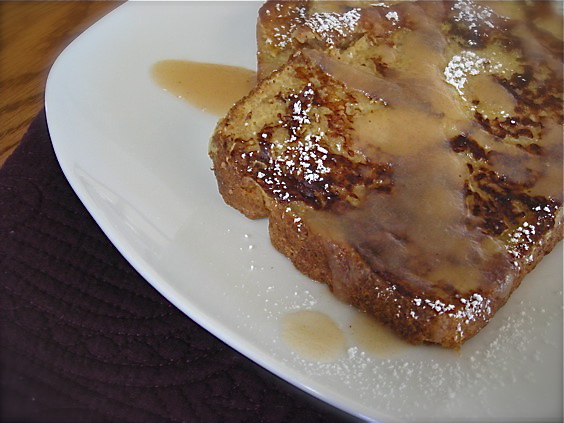
My slices turned out perfectly; crispy yet tender with a perfect sweet and tart Rhubarb flavor. I drizzled some of my own scratch pear butter over the top, adding a snowy dusting of powdered sugar because it’s French Toast, isn’t it? It’s simpatico with powdered sugar. And you know what? It didn’t even need anything. The fruit adds a nice sweetness to the slices, and fresh from the skillet, all you really need is a plate and a fork. That and a gnawingly empty stomach. I munched and sighed my way through four slices watching the sun shine brightly and the newly green trees whip around in a stiff wind. This is one of those dishes that would only pass my lips in this house; Mike is anti-egg and Griffin won’t eat rhubarb. So it was perfect for a gorgeous and solo Sunday morning.
November 28th, 2008
| 2 Comments »
Endless speculation abounds about why battered and fried bread slices are called ‘French’ toast, but never is there an appropriate response to the question ‘Why is it called French Toast?’ What’s french about it??
Yes, it’s National French Toast Day. So let’s lay waste to the ongoing debate about the French-ness of French Toast.
The earliest understanding of how this dish came to be is to look as far back as the northern French Normans who created a dish called ‘tostees dorees‘ that was a battered and fried bread. It was similar to a popular dish in England in the Middle Ages that was named suppe dorate, and is considered a knock-off of the Normandy dish. Ironically, in France and Belgium currently, you can get Pain Perdu, loosely translated as ‘lost bread’. The egg mixure that is allowed to soak into the slices is a way of reclaiming old, stale bread, or lost bread and making it edible. So the Normans from France did apparently create a similar dish to the current manner of French Toast, but are they really the ones who should be credited with the discovery? According to many sources, the initial documentation of the dish is known to be at the time of Henry the V of England (1413-1422). Definitely NOT French.
There are dozens- I mean, dozens– of variations of this dish in all countries around the world:
- Austria: Pavese (a medieval type of shield whose shape resembles a slice of bread)
- England: suppe dorate (Italian for “gilded sippets”)
- France: pain perdu (literally, “lost bread”)
- Germany: Armer Ritter (literally, “poor knight”; the name is sometimes meant to originate from poor knights in Medieval times, having not enough gold to pay for meat, and thus eating old bread slices, coated with egg and fried )
- Hungary: bundás kenyér (literally, “coated bread” or “bread with fur”) [<— mmmm, yummy]
- Portugal: rabanadas or fatias douradas (literally, “golden slices of bread”)
- Yugoslavia and some successor republics: прженице – prženice
- Croatia: pohani kruh
- Lebanon: pain perdu
- Catalonia: torrades o croquetes de Santa Teresa (literally, “toasts or croquettes of Saint Theresa”)
And then there are so so many more that it seems silly to post them. It’s not French and barely can claim any French origin. But it is delicious. Especially with homemade lemon curd.
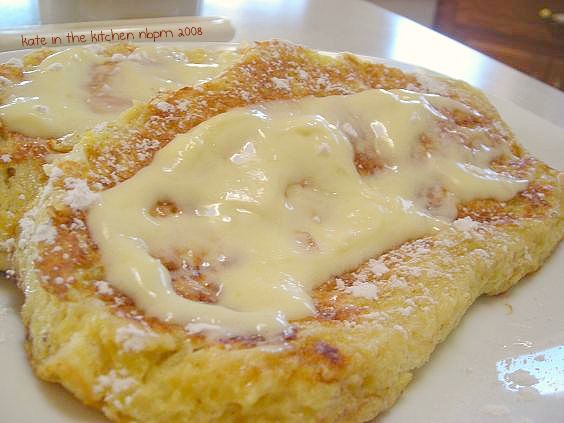
I had a loaf of sourdough bread that I chopped up for croutons to put in my Thanksgiving stuffing and there were four good-sized slices left over that were just crying out to be made in Egg Bread. (hehehe- I’m not calling it by that name) The lemon curd-which you’ll have to come back tomorrow to read about- was just a perfect topping for the warm slices sprinkled liberally with powdered sugar.
I know that everyone has their own manner of making Egg Bread and what goes into the batter but I’ll just tell you my version anyway. Eggs and milk (vanilla soy milk- ooooh yummy like a milkshake) and a tablespoon or two of cinnamon sugar and some fresh ground nutmeg. The sugar crystals in the batter help with caramelization. I have also made my batter from vanilla or banana yogurt with excellent results. I’m not really a syrup girl but I do like honey drizzled over the slices, or I spread them with fresh fruit, jam, apple butter or simply a little melted butter.

Well there’s TWO days left of National Blog Posting Month and my November desk calendar is criss-crossed with hash marks as I have methodically checked off the days and their corresponding food holiday. It’s been a great deal of fun with plenty of good learning but I’ll tell ya, I am looking forward to stepping away from the computer for a while and re-grouping before getting back into something of a more normal blogging routine. For those of you who have stuck with me through this adventure, I thank you profusely and hope you continue visiting.
|






